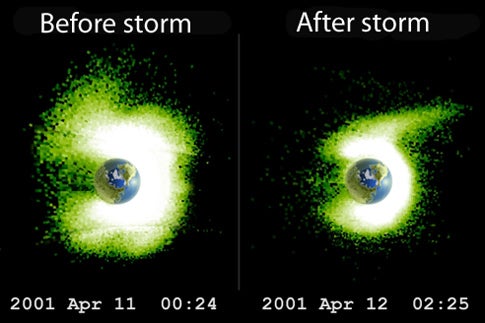An earthbound network of Global Positioning System (GPS) receivers that studies continental movement recently made a high-altitude discovery. Along with observations from NASA’s Imager for Magnetopause-to-Aurora Global Exploration (IMAGE) satellite, scientists used the GPS network to study how space weather affects radio reception, specifically GPS-receiver readings.
The results, announced at the American Geophysical Union’s fall meeting this week in San Francisco, may make it possible to inform GPS users — from farmers to pilots — that their receivers will display the wrong information.
By comparing time signals from different satellites, GPS receivers calculate their own positions. The ultra-precise receivers from the International GPS Service for Geodynamics (IGS) use the same method to track the slow creep of continental plates.
But Jerry Goldstein of the Southwest Research Institute in San Antonio, Anthea Coster of MIT’s Haystack Observatory in Westford, Massachusetts, and Toni Mannucci of NASA’s JPL in Pasadena, California, used the receivers to measure conditions in the ionosphere — the layer of the atmosphere where the Sun’s ultraviolet light kicks electrons away from their atoms and leaves positively charged ions behind. The ionosphere’s electric fields delay GPS radio signals as they pass from satellites to receivers. By comparing the different delays of GPS signals with different frequencies, the researchers calculated how many charged particles the signals passed on their way to the receiver. In other words: They measured the thickness of the ionosphere.
Charged particles also play the lead role in geomagnetic storms. During these storms, the Sun spews out a part of its outer layer, which may head toward Earth. This hot cloud of electrons and ions — plasma — then collides with Earth’s doughnut-shape magnetic field. This collision deforms the cocoon and blows away part of its plasma as a long, tapering plume.
Geomagnetic storms can have noticeable consequences on Earth. On the ground, the changing magnetic field can induce damaging voltages in long power lines. In the ionosphere it can a deteriorate of the quality of radio broadcasts.
While monitoring the state of the ionosphere all over the globe during a couple of storms in 2001 and 2003, Coster and her colleagues discovered this disruption of the ionosphere is far from chaotic. Changes in Earth’s magnetic field, which stays connected to the plume as it is pushed away, cause powerful electric fields in the outer layers of the atmosphere. An electric “footprint” of the plume drags over the ionosphere, much like a cold front moves through a weather system.
When such a disturbance occurs over North America, it takes the form of a southeast-to-northwest corridor, a few hundred miles wide, where radio reception suffers. Along its edges, GPS readings may be off by tens of yards instead of just a few.
According to Coster, GPS receivers won’t soon be able to compensate for that. But a weather report telling pilots not to use their GPS for a couple of hours would help.










